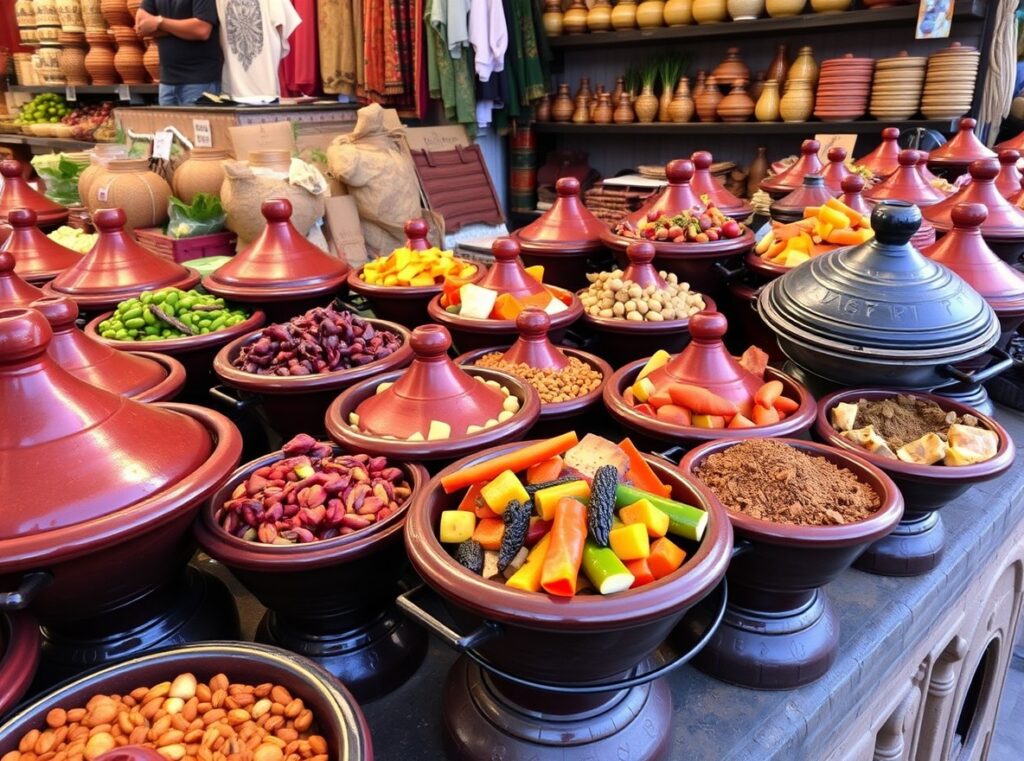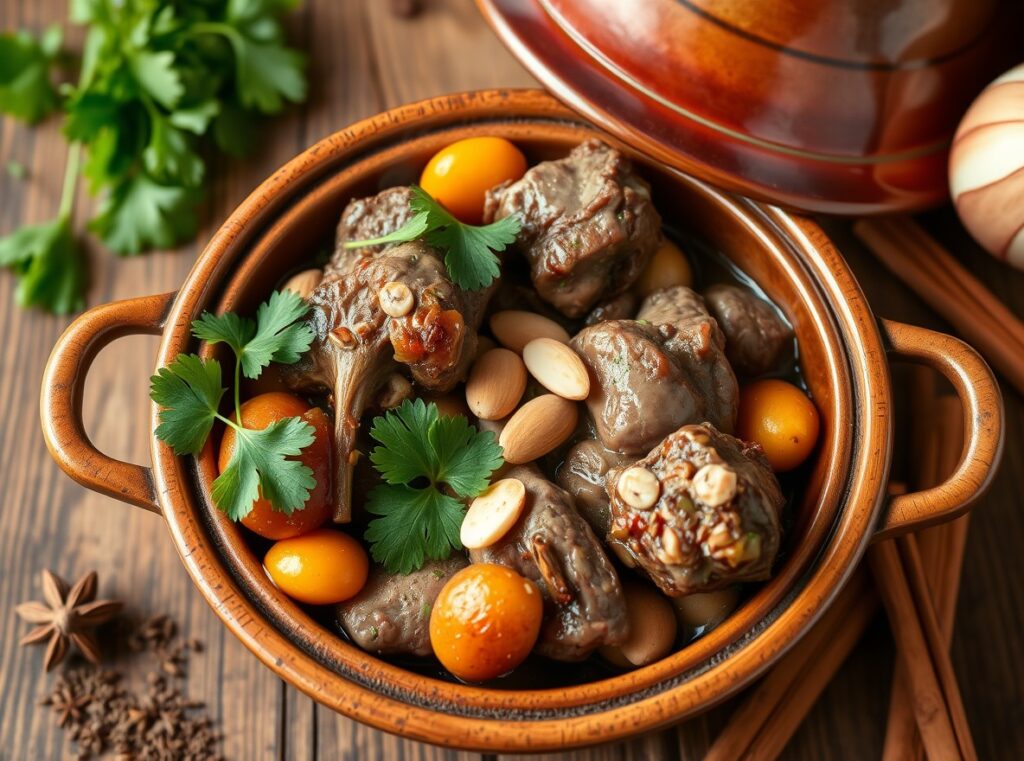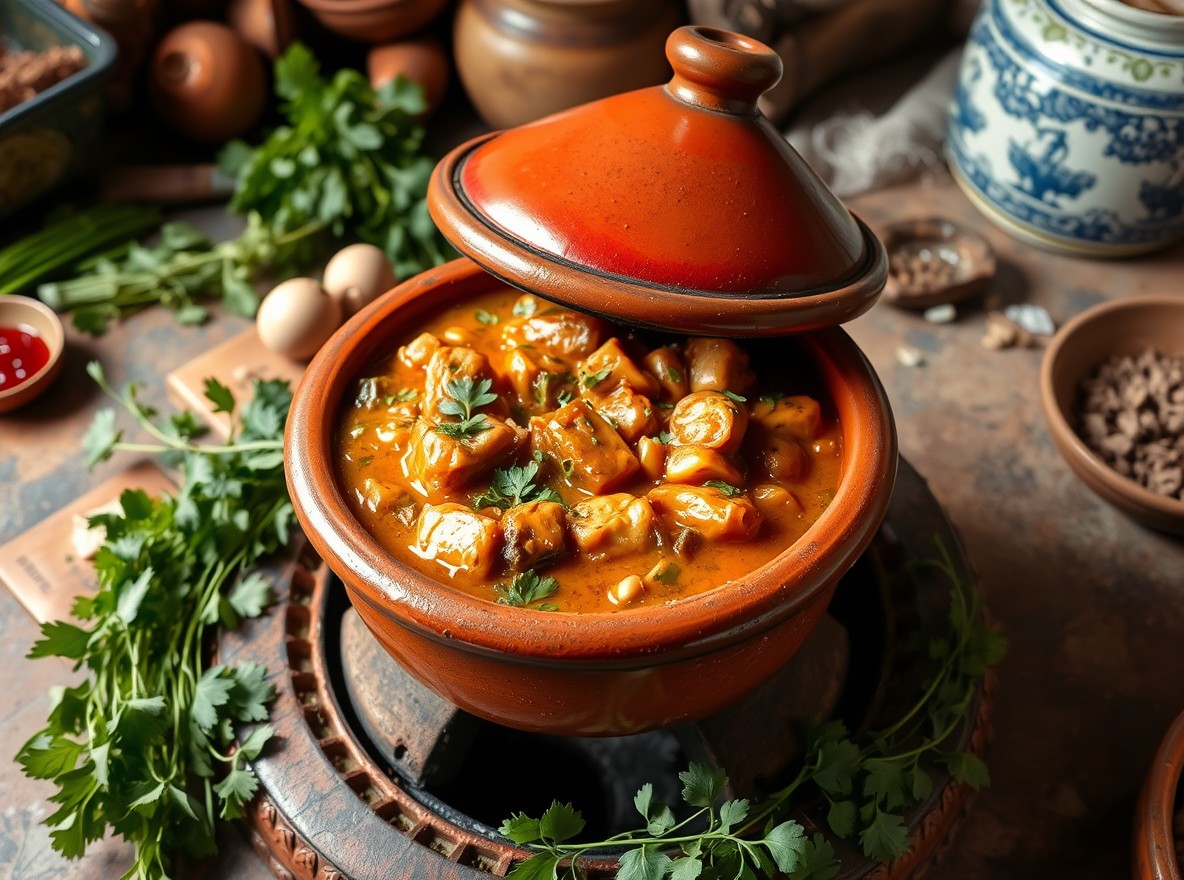Introduction
One of the most famous foods in Morocco, Tagine is celebrated for its deep flavors, slow-cooked tenderness, and aromatic spices. More than just a meal, this dish embodies Moroccan hospitality and culinary heritage. Whether enjoyed in a bustling souk, a family gathering, or a high-end restaurant, it’s a must-try for food lovers. But what makes this dish so special? Let’s explore its history, ingredients, and significance in Moroccan culture.


History & Cultural Significance
This traditional Morocco food has roots that date back to the Berbers, indigenous North African people who perfected slow-cooking techniques centuries ago. The name “Tagine” originates from the Arabic word for “shallow earthenware pot.” Historically, Moroccan nomads used these pots to prepare meals over open fires, allowing for slow cooking with minimal water—a crucial adaptation for desert life.
Over time, the dish became an essential part of Moroccan cuisine, influenced by Arab, Andalusian, Ottoman, and French culinary traditions. Today, it remains a staple at Moroccan celebrations, family gatherings, and even street food markets.
Ingredients & Regional Variations
Key Ingredients:
Meat (lamb, chicken, beef, or fish) or vegetarian options with chickpeas
Spices such as cumin, cinnamon, turmeric, paprika, and saffron
Olive oil and preserved lemons for extra depth
Fresh vegetables like tomatoes, carrots, potatoes, and olives
Dried fruits like apricots, prunes, or raisins for a sweet-savory balance
Nuts such as almonds or pine nuts
Regional Variations:
Marrakech Style: Typically features lamb, prunes, almonds, and sesame seeds, offering a sweet and savory profile.
Fes Specialty: Known for its use of chicken, preserved lemons, and green olives.
Saharan Version: Often cooked with camel meat and desert spices.
Seafood Option: Found in coastal cities like Essaouira, made with fresh fish, shrimp, and tomatoes.
Vegetarian Style: Loaded with seasonal vegetables, chickpeas, and aromatic spices.
Cooking Process & Difficulty Level

This dish is beginner-friendly but requires patience for slow cooking.
Step-by-Step Guide:
Heat olive oil in a heavy-bottomed pan.
Sauté onions, garlic, and spices until fragrant.
Add meat or vegetables, coating them in the spice mixture.
Pour in broth or water, cover, and cook on low heat for 2-3 hours.
Add dried fruits, olives, and nuts towards the end.
Serve hot with couscous or crusty bread.
Where to Eat Tagine in Morocco
Café Clock (Marrakech & Fes): A fusion of traditional and modern Moroccan cuisine.
Dar Moha (Marrakech): High-end dining with authentic flavors.
La Maison Bleue (Fes): A luxurious riad offering an unforgettable dining experience.
Nomad (Marrakech): Trendy spot with classic Moroccan dishes.
Street food stalls in Jemaa el-Fnaa (Marrakech): Budget-friendly and authentic.
Pairing with Drinks & Side Dishes
Drinks: Best paired with Moroccan mint tea, red wine, or freshly squeezed orange juice.
Side Dishes: Often served with fluffy couscous, fresh bread, or a side of zaalouk (eggplant salad).
Fun Facts & Lesser-Known Trivia
The unique shape of the cooking pot allows condensation to drip back, keeping food moist.
Moroccan families often pass down secret spice blends through generations.
The world’s largest dish of this kind was made in Agadir, Morocco, weighing over 6,000 pounds!
Health Benefits & Nutrition
This Moroccan specialty is a nutritious dish rich in proteins, fiber, and essential vitamins:
High in antioxidants: Thanks to spices like turmeric and cinnamon.
Rich in healthy fats: From olive oil and nuts.
Gluten-free & adaptable: Easily modified for vegan, keto, or paleo diets.
How to Cook It at Home (Best Tagine Recipe)
Ingredients:
1 lb lamb or chicken (or chickpeas for vegetarian option)
2 onions, finely chopped
2 cloves garlic, minced
1 tsp cumin, 1 tsp cinnamon, 1 tsp paprika, ½ tsp saffron
2 tbsp olive oil
½ cup prunes or apricots
2 preserved lemons, chopped
1 cup vegetable or chicken broth
½ cup green olives
Handful of almonds
Method:
Heat olive oil and sauté onions and garlic.
Add meat (or chickpeas) and brown on all sides.
Stir in spices and mix well.
Pour in broth, cover, and cook on low for 2 hours.
Add dried fruits, olives, and almonds, cook for 15 more minutes.
Serve hot with couscous or bread.
Global Influence & Fusion Cuisine
This dish has influenced global cuisine, inspiring:
French-Moroccan fusion dishes with wine reductions.
Modern adaptations using tofu or jackfruit for vegan versions.
International slow-cooked stews in gourmet restaurants worldwide.
Comparison with Similar Dishes
Versus Indian Curry: Both are slow-cooked but use different spice profiles.
Versus French Coq au Vin: Both involve slow simmering but differ in ingredients.
Versus Mexican Barbacoa: Similar in slow cooking but vastly different in seasoning.


One thought on “Tagine: Morocco’s Iconic Dish – History, Recipe & Best Places to Try”